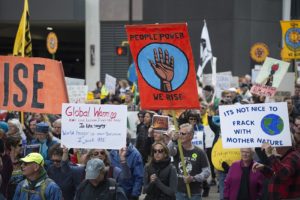Let’s admit it: large numbers of people participating in our social justice campaigns are impressive–to media, funders, and the people we aim to influence.
But how do we value and measure the commitments, activities, and relationships that give us the collective power–or people power–to influence campaign targets and drive systems change? That’s the question we’d been hearing more and more and why we teamed up with a dozen partners to find some answers.
People power may never be fully measurable, but we know that it encompasses at least three things. Measuring these in parallel is the holy grail, but right now few organisations are coming close to measuring the full value of people working together in concert.
- breadth of a campaign or organisation’s reach
- depth of sustained engagement and leadership, and
- impact these factors have on achieving the mission.
It seems we’ve taken a “digital shortcut” over the last decade, leveraging new technologies to build unprecedented numbers of followers and supporters for our campaigns while neglecting equally essential investments in volunteers, supporters and members. For many organisations, and even social movements, building breadth has actually come at the expense of building depth of support and therefore long term power.
Breadth is helpful but insufficient for achieving systemic change. We know that lasting radical change requires both broad and deep engagement. We partnered with more than a dozen social change organisations to map how changemakers around the world are measuring people power in breadth, depth, and impact.
MobLab's key takeaways
Here are our key takeaways from this groundbreaking research, for everyone from activists to organisational staff/leaders and funders.
For changemakers, if you’re not already measuring depth of supporter relationships and engagement (vs total numbers, or breadth), this report highlights a few ways to get started. Whether in a grassroots group, social movement, or an established NGO, tracking how committed people are to your mission (and to one another) and facilitating deeper relationships can be a big step forward.
For organisational leaders, this report is an urgent call to support cultures that are curious, innovative, and supporter- or people-centred. The results also clarified the importance of investing in staff and resources needed to build relationships with volunteers, grassroots, and community groups. The majority of the surveyed individuals found the very effort of measuring people power shifted and informed both tactics and strategy, guided day-to-day decision making, and was used to evaluate the past; essentially, to show them what was working and what wasn’t.
For funders, the results underscore the need to support organisations, groups and movements by investing in organising and power building, which don’t come with the same attractive metrics that we typically see in fundraising and digital advocacy. Funders should support both the implementation of sustained organising and supporter relationship building (outside of short term programme objectives) and ongoing development and experimentation in power building or “depth” metrics.
Measuring People Power has uncovered a new baseline for how social change organisations are measuring depth of engagement, such as the often under-recognized and under-appreciated work of individuals, volunteers and grassroots groups (not to mention the under-resourced staff who support them).
The majority of the surveyed individuals and organisations reported attempting to measure depth of engagement in different ways, and expressed frustration and excitement at the challenges and results. ‘Measuring People Power’ proves that there is a next generation of social change organisations and change makers committed to testing, building, and measuring people power in new and impactful ways.
Most strikingly, a majority of respondents agreed that the very effort of measuring people power helped them identify points of failure, evaluate new approaches, and resulted in tangible changes in their work.
For all of us, this project offers a first look at the current lay of the land. Measuring People Power is a wake-up call that should show us how far we are from adequately valuing and measuring people power, but how committed and curious current changemakers and organisations are by attempting it, with all of the resources and creativity that they possess.
Understanding people power and measuring it will be one of the most important things that we can do to achieve our social change missions. We are not yet able to share proven best practices, but we are sharing promising and creative methods that changemakers are exploring to measure perhaps the most valuable resource any of us could hope to build: people power.
We hope to support more social justice victories by sharing these attempts at measuring breadth, depth and mission-based impact–and continuing to learn.
Join the #MeasuringPeoplePower conversation on social media as we continue to track case studies, learn, and share examples of what’s new and exciting in this field.
Thank you to all of our partners who have made this research possible, asked difficult questions, and are guiding examples of #MeasuringPeoplePower today: 350.org, Care2, Greenpeace, FRIDA The Young Feminist Fund, Climate Advocacy Lab, DoBigGood, The Movement Cooperative, Save The Children, The Story of Stuff, Blueprints For Change, Research 4 Impact, Ford Foundation, Net Change, OPEN (The Online Progressive Engagement Network)




